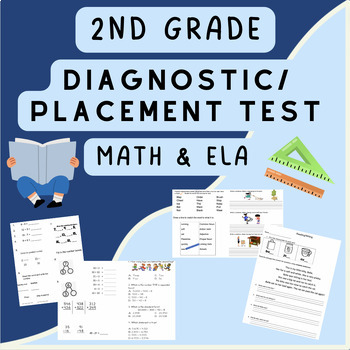2nd Grade Placement/Diagnostic Test- Math and ELA
- Zip
What educators are saying
Also included in
- ⭐️ REVIEWS"Used this for tutoring as a diagnostic on our first meeting to see what gaps needed to be filled before we started meeting regularly."⭐️ DESCRIPTIONThis is bundle of 3 different diagnostic tests designed to find the placement level of 1st grade, 2nd grade, or 3rd grade students in the areasPrice $9.40Original Price $11.75Save $2.35
- ⭐️ REVIEWS"Used this for tutoring as a diagnostic on our first meeting to see what gaps needed to be filled before we started meeting regularly.""These are great tests for the students and saved me a lot of time.""This is a great resource. I was able to get a better idea on what specific skills thatPrice $18.25Original Price $21.25Save $3.00
Description
⭐️ REVIEWS
"Used this for tutoring as a diagnostic on our first meeting to see what gaps needed to be filled before we started meeting regularly."
⭐️ DESCRIPTION
These tests are designed to be given at the beginning of the year to assess what the students know coming into the school year. These can be used at the beginning of the year in 2nd grade to see what the students know before the school year starts, throughout the year to continuously find the level of the students or to find the weak and strong areas for each student. Additionally, this could be used at the end of the year in 1st grade to assess their progress and what they already know for the upcoming year. These tests could also be used as a review at the beginning of the year in 3rd grade.
Math:
This test can be used to see what areas the students are lacking in or the most successful in. There is a mix of operations such as multiplication, addition, subtraction, and division, as well as questions involving word problems.
**Recently added: An additional ELA test created for "lower-level" or English as a Second Language (ESL) Students.
**All answer-keys are now included as well!
Standards:
- CCSS1.NBT.A.1: Count to 120, starting at any number less than 120. In this range, read and write numerals and represent a number of objects with a written numeral.
- CCSS1.NBT.B.2a: 10 can be thought of as a bundle of ten ones - called a “ten.”
- CCSS1.NBT.C.4: Add within 100, including adding a two-digit number and a one-digit number, and adding a two-digit number and a multiple of 10, using concrete models or drawings and strategies based on place value, properties of operations, and/or the relationship between addition and subtraction.
- CCSS1.NBT.C.5: Given a two-digit number, mentally find 10 more or 10 less than the number, without having to count; explain the reasoning used.
- CCSS1.OA.B.3: Apply properties of operations as strategies to add and subtract. If 8 + 3 = 11 is known, then 3 + 8 = 11 is also known. (Commutative property of addition.) To add 2 + 6 + 4, the second two numbers can be added to make a ten, so 2 + 6 + 4 = 2 + 10 = 12. (Associative property of addition.).
- CCSS1.OA.B.4: Understand subtraction as an unknown-addend problem. For example, subtract 10 – 8 by finding the number that makes 10 when added to 8.
- CCSS1.OA.C.6 Add and subtract within 20, demonstrating fluency for addition and subtraction within 10. Use strategies such as counting on; making ten
- CCSS1.OA.D.8 Determine the unknown whole number in an addition or subtraction equation relating three whole numbers.
- CCSS2.OA.B.2 Fluently add and subtract within 20 using mental strategies. By end of Grade 2, know from memory all sums of two one-digit numbers.
ELA:
This test has a mix of questions with reading and comprehension, ending sounds, reading accuracy, parts of speech matching, complete sentences, and vocabulary.
Standards:
- CCSSRL.2.7 Use information gained from the illustrations and words in a print or digital text to demonstrate understanding of its characters, setting, or plot.
- CCSSRL.2.10 By the end of the year, read and comprehend literature, including stories and poetry, in the grades 2–3 text complexity band proficiently, with scaffolding as needed at the high end of the range.
- CCSSCCRA.W.4 Produce clear and coherent writing in which the development, organization, and style are appropriate to task, purpose, and audience.
- CCSSCCRA.L.1 Demonstrate command of the conventions of standard English grammar and usage when writing or speaking.
- CCSSCCRA.L.2Demonstrate command of the conventions of standard English capitalization, punctuation, and spelling when writing.
⭐️ YOU MIGHT ALSO LIKE
1st Grade Placement/Diagnostic Test- ELA, Math, Science- 20+ standards
3rd Grade Placement/Diagnostic Test- Math and ELA






